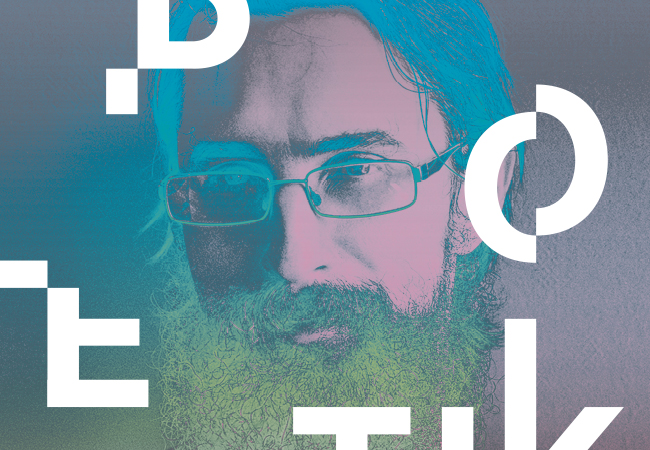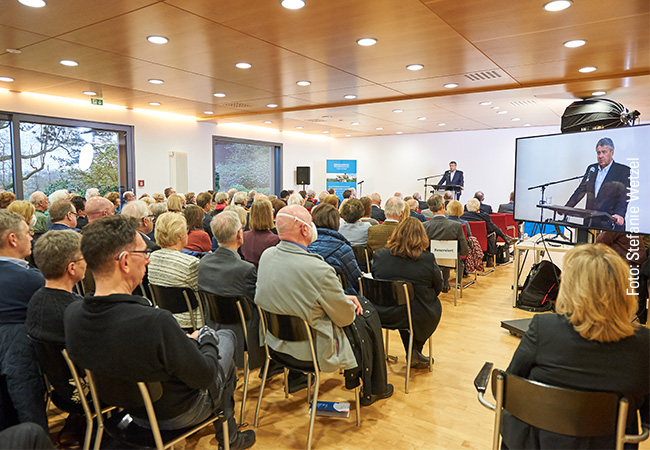The Humanities Library (Bibliothekszentrum Geisteswissenschaften, BzG) is the oldest departmental library on Goethe University’s Westend Campus. Its books, media and services are located in the two outermost wings of the IG Farben Building.
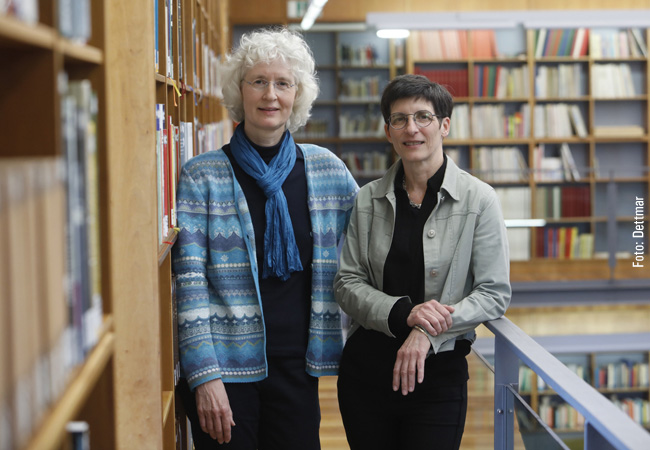
Anyone not familiar with the BzG may wonder why you can only enter the library from the third, rather than the ground floor of the IG Farben Building. There is, in fact, a logical reason for what may at first seem like an odd choice: The library occupies all floors of the building’s two outermost wings. It owes this rather unusual arrangement both to the building’s structure as well as pragmatic considerations. The IG Farben Building’s two outer wings (labeled Q1 and Q6) offer the greatest amount of space per floor. Located between the library’s wings are the institutes the BzG primarily serves – which is why access to the library is located in the middle of each wing. Directly facing the entrance is the information desk, the contact point for anyone with a question for the librarians. Another library entrance is located on the first floor of the Q6 wing; it is here where the connecting corridor to the adjoining building is located. BzG deputy director Ursula Lenk, who worked as librarian of the Institute of English and American Studies after graduating, witnessed the latest reincarnation of the IG Farben Building and knows about the multitude of challenges associated with moving into the renovated landmark building. BzG director Christiane Schaper, who has a degree in librarianship from Humboldt-Universität zu Berlin, joined the BzG in 2005 after stints at several other libraries.
Moving into the IG Farben Building
The BzG was founded in 2001, when more than 20 departmental libraries in the humanities, previously housed at various sites in Bockenheim, were brought together in the IG Farben Building. This was made possible by the departure of the American military command, who had used the building since the end of the Second World War. Lenk recalls: “That was a huge challenge. For one, the library collections had to be arranged in a sensible manner in the various reading rooms. What’s more, the staff from 20 different departmental libraries first had to grow into a new single team, working together to get the library working as a combined unit.” The merger offered many advantages to students. As such, while the departmental libraries had offered differing and much more limited opening hours, the BzG has standardized and much longer opening hours for all subjects and departments.
Whereas other departmental libraries such as the Law and Economics Library (Bereichsbibliothek für Rechtswissenschaft und Wirtschaftswissenschaften, BruW), tend to be housed horizontally, the BzG is arranged vertically, comprising nine floors in Q1, and eight floors in Q6. “The outermost wings have the most space for books, but the ceilings had to be reinforced to bear the books’ immense weight. Formerly used to house administration, the building actually was not suitable for use as a library,” Schaper explains. That being said, she does like the unconventional positioning of the library’s two parts: “You could say the library in a way constitutes a frame for the humanities subjects that reside here – a nice way of looking at it, I find. Besides that, it is important for us to be in close contact with the subjects represented here. We want to uphold this dialog with the disciplines, to ensure that we can align the further development of our library services to the needs of both teaching staff and students.”
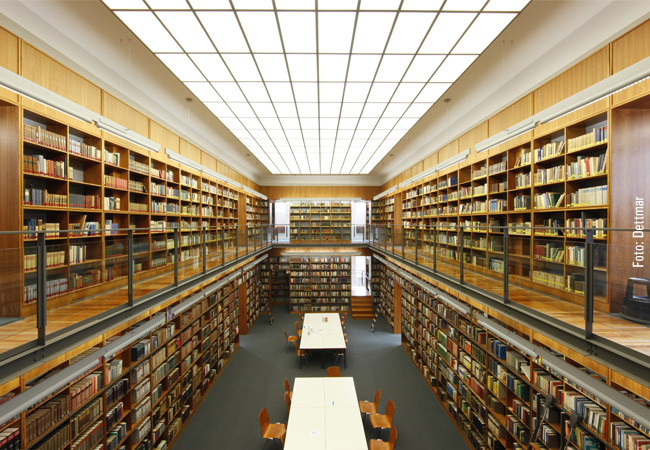
A key component of a library’s operation is to provide good orientation for users. New users especially have to understand the way the stocks are arranged. “The two wings of the BzG are about 200 meters apart. To avoid an unnecessary trek between the two, we advise users to use the online catalog to find the exact location of the items they want,” Schaper says. Library staff have also devised an audio guide explaining the basics and encouraging users to try their hand at smaller research tasks. In some courses of study, first-years are required to use the audio guide and subsequently absolve a small test, which helps familiarize them with the BzG. Additional training courses in information skills and research are closely linked to specific subjects, and library staff offer courses that are integrated into classes or tutorials.
From sports hall to reading room
A rare jewel in the library world is the BzG’s reading room in Q1, which spans two stories and has often featured in glossy brochures. When the building was first established, this space served as the main meeting room of chemical company IG Farben AG. The US army later converted the space into a sports hall. When Goethe University moved into the building, the space was repurposed once more, and turned into a library reading room. Today it includes a gallery, an illuminated ceiling and wooden paneling, lending it a representative appearance while at the same time adhering to the building’s functional style. For library users, the space offers an especially agreeable atmosphere conducive to concentrated learning. “Some students call the two-story reading room the Harry Potter Reading Room,” Lenk says with a smile.
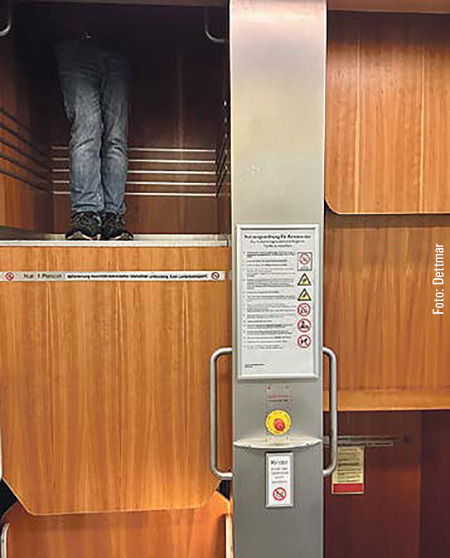
The library’s most unusual feature, however, may be the wooden paneled paternoster elevator, which takes passengers swiftly from one floor to another. “The paternoster is incredibly important to us because we often have to switch between the floors. If you are on the ground floor in Q1, say, and you want to leave the library, you have to get to the third floor again,” Schaper explains. This rare, but very practical mode of transport lends the BzG the flair of a bygone age.
It is obvious that users like the library, which offers workspaces in differently sized rooms. “Some prefer working in the peace and quiet of the small rooms, while others find the atmosphere in the large reading rooms with a lot of other students more motivating.” Anyone sitting in one of the BzG’s numerous reading rooms is located in the immediate vicinity of the library’s various humanities collections – another advantage of having merged the separate libraries into a single comprehensive humanities library. The books are easily accessible and systematically arranged. It’s worthwhile to look around and discover more books on the same subject.
One special BzG feature is the library for research into children’s books, whose opening hours differ from those of the main library and which also has a separate information service. The specialized library aims to collect all primary German-language literature in this field.
“Digitalization plays an increasingly important role in the humanities, too,” Schaper emphasizes. The proportion of e-books and e-journals is rising, along with interest in open-access publications. Schaper attaches particular importance to the “Praxislabor Digital Humanities” [Digital Humanities Practice Lab], introduced in 2018. This new service is based on a similar format used at the University Library in Marburg. Under the aegis of Agnes Brauer, University Library officer for digitalization projects and digital humanities, library staff offer workshops for employees and students on various tools and methods used in the “digital humanities”. The practice lab started out as a face-to-face format, but today most of its workshops are held online, allowing interested staff and students from other Hessian universities to attend, too. The offer continues to enjoy great popularity.
All told, humanities libraries will continue having to operate in hybrid form – i.e. as both analog and digital libraries. “Printed books may soon disappear in other disciplines. For us, that is not the case. We have to cope with this dual challenge,” say Schaper and Lenk, adding that, “the service and advice we offer to both students and teaching staff is the result of the combined efforts of all BzG staff, including our student assistants.”
FACTS AND FIGURES ABOUT THE BZG
Subjects represented
Theology (Faculties of Protestant Theology and Roman Catholic Theology), Philosophy and History (Faculty of Philosophy and History), Archaeological Studies, Classical Philology, Cultural Anthropology and European Ethnology (Faculty of Linguistics, Cultures, and Arts) and Modern Languages (Faculty of Modern Languages)
Workspaces
800 workspaces in 39 reading rooms,
7 small group rooms, 2 large group rooms, and 1 large non-reservable group room for several groups simultaneously
Stock
Approx. 1,260,000 media units
Staff
26 employees (21.4 full-time equivalents), 11 of them full time,
6 half-time, 8 with reduced working hours, supported by a large number of student assistants, 16 of them to maintain the opening hours
Area
Approx. 8,200 square meters
Opening hours
Mon. to Fri. 8 a.m. to 10 p.m.
Sat. 10 a.m. to 10 p.m.



